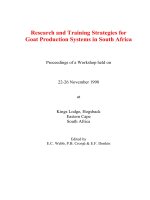Space sharing strategies for storage yard management in a transshipment hub port
Bạn đang xem bản rút gọn của tài liệu. Xem và tải ngay bản đầy đủ của tài liệu tại đây (1.98 MB, 158 trang )
SPACE-SHARING STRATEGIES FOR STORAGE YARD
MANAGEMENT IN A TRANSSHIPMENT HUB PORT
JIANG XINJIA
NATIONAL UNIVERSITY OF SINGAPORE
2012
SPACE-SHARING STRATEGIES FOR STORAGE YARD
MANAGEMENT IN A TRANSSHIPMENT HUB PORT
JIANG XINJIA
(B.Eng., Nanjing University)
A THESIS SUBMITTED
FOR THE DEGREE OF DOCTOR OF PHILOSOPHY
DEPARTMENT OF INDUSTRIAL AND SYSTEMS
ENGINEERING
NATIONAL UNIVERSITY OF SINGAPORE
2012
i
Declaration
I hereby declare that the thesis is my original work and it has
been written by me in its entirety. I have duly
acknowledged all the sources of information which have
been used in the thesis.
This thesis has also not been submitted for any degree in any
university previously.
______________________
Jiang Xinjia
23 Sep 2012
ii
Acknowledgement
In memory of my mother who guided me with her wisdom, passion and determination.
This thesis would never have been written without the support from the people who
enriched my knowledge and experience in many ways.
I would like to express my deepest appreciation to my two supervisors, A/Prof. LEE
Loo Hay and A/Prof. CHEW Ek Peng. They offered me invaluable guidance and
encouragement through the whole course of my research. I would also like to thank
A/Prof. TAN Kok Choon, who generously provided me with his expertise on port
operations.
Gratitude also goes to all other faculty members in the Department of Industrial and
Systems Engineering for their kind attention and help in my research.
I am also grateful to my peers and fellow students in the Department of Industrial and
Systems Engineering. Thank you for sharing your experience on research and life in
Singapore during the four years.
Last but not least, I would like to thank my family for their continuous support and
understanding, especially my father. It was your encouragement that helped me stand
up and survive from the tough period.
______________________
Jiang Xinjia
iii
Table of Contents
Declaration i
Acknowledgement ii
Table of Contents iii
Summary vi
List of Tables viii
List of Figures ix
List of Abbreviations xii
List of Notations xiv
Chapter 1. Introduction 1
1.1 Background of container terminals 2
1.2 Storage yard management 4
1.3 Space allocation planning 6
1.4 Contribution of the thesis 8
1.5 Organization of the thesis 10
Chapter 2. Literature Review 12
2.1 The design of storage yard 14
2.1.1 Equipment selection 14
2.1.2 Yard layout and configuration 14
2.1.3 Decision support and simulation systems 15
2.2 The transport vehicle management 16
2.2.1 Fleet sizing problem 16
2.2.2 Vehicle dispatching problem 16
2.3 The yard crane management 18
2.3.1 Yard crane dispatching 18
2.3.2 Yard crane deployment 21
iv
2.4 The storage space management 23
2.4.1 Location assignment 23
2.4.2 Space allocation 27
2.5 Research gaps and motivations 30
Chapter 3. The Partial Space-sharing Strategy 32
3.1 Problem description 32
3.2 Solution approaches 37
3.2.1 Template generation 39
3.2.2 Two different methods for space allocation and workload assignment
44
3.3 Numerical experiments 54
3.3.1 Experiment descriptions 54
3.3.2 Experiment results 55
3.4 Conclusions 58
Chapter 4. The Flexible Space-sharing Strategy 60
4.1 Problem description 60
4.2 Model formulation 62
4.3 Solution approaches 69
4.3.1 Decomposed model for one shift 71
4.3.2 Shift-picking methods 74
4.4 Numerical experiments 77
4.4.1 Performance of flexible space-sharing strategy 79
4.4.2 Comparison of shift-picking methods 80
4.4.3 Impact of the yard crane limit 82
4.4.4 Effect of the sub-block size 83
4.5 Conclusions 85
Chapter 5. Short-term Space Allocation 86
5.1 Problem description 86
5.2 Model formulation 89
5.2.1 MIP model for the GSA method 90
5.2.2 MIP model for the SALP method 97
v
5.3 Numerical experiments 102
5.3.1 Experiment description 102
5.3.2 Comparison of short-term planning methods 104
5.3.3 Comparison between the storage strategies 109
5.4 Conclusions 112
Chapter 6. Conclusions and Future Research 114
Bibliography 117
Appendices 134
Appendix A: Candidate’s publication list arising from the PhD
work 134
vi
Summary
In transshipment ports, the containers to the same destination vessel are usually stored
together to facilitate the loading process, which is called the “consignment”. The
“yard template” is used to define the reservation of the storage locations for
destination vessels. However, the consignment strategy is known to be inefficient in
space utilization since each storage location must be dedicated to a particular vessel.
To improve the space utilization while retaining the advantage of consignment, new
storage strategies are proposed in this thesis, namely the “partial space-sharing
strategy” and the “flexible space-sharing strategy”.
In the “partial space-sharing strategy”, part of the storage space is allowed to be
shared between two adjacent storage locations. The space in each storage location is
divided into non-sharing and sharing parts. When less space is needed by a storage
location, the sharing space in this storage location can be lent to the adjacent locations.
The sharing space will then be returned, before the major workload comes into this
storage location. Since the major containers to each destination vessel arrive at
different periods, the storage locations preserved for the vessels will also need the
sharing space during different shifts. An integrated framework is developed to decide
the yard template and the container assignment at the same time. Two approaches are
proposed to decide the size of sharing and non-sharing space in each storage location.
Experimental results show that the partial space-sharing strategy is able to improve
the land utilization, while guaranteeing the least yard crane deployment.
In the “flexible space-sharing strategy”, the same storage location is allowed to be
reserved for two vessels. The amount of space will only be allocated to a specific
vessel on the arrival of corresponding containers. By controlling where to stack the
vii
containers in the storage locations, the containers to each vessel are not mixed and the
consignment feature can be preserved. This strategy is first formulated as a mixed
integer program. As the MIP model has a block diagonal structure, we develop a
search algorithm which combines MIP and heuristics to find the solution. The results
show that the “flexible space-sharing strategy” can handle much more containers
within the same storage space compared with the “non-sharing strategy”.
In the previous studies, the storage strategies are all studied for long-term planning.
During the operation, the actual containers that will come in are only known for a
short period in advance. Thus, short-term space allocation is needed to assign the
incoming containers taking into account of transport vehicles, yard cranes and space
capacity. Currently, the space is allocated based on the experience of port operators
and the rule of thumb. To remedy this, we develop two systematic short-term
planning methods, namely the “greedy space allocation (GSA)” and the “space
allocation considering the long-term plan (SALP)”. MIP models are formulated for
the two methods respectively. The numerical experiments show that the SALP
method is preferred over the GSA method, but the portion of long-term plan
considered affects the performance of the SALP method.
viii
List of Tables
Table 4.1 Comparison of the two storage strategies 80
Table 5.1 Parameter setting for different storage strategies 94
ix
List of Figures
Figure 1.1 Growth of container traffic 1
Figure 1.2 Components and operations in a typical container terminal 2
Figure 1.3 Import, export and transshipment 3
Figure 1.4 General picture of the storage yard 5
Figure 1.5 Container stacking in a block 5
Figure 2.1 The structure of literature review 13
Figure 3.1 A storage yard configuration 33
Figure 3.2 The buildup pattern of the coming workload for one vessel 33
Figure 3.3 Schematic diagram of one block for the static yard template and the space-
sharing yard template 34
Figure 3.4 A schematic diagram for space capacity of one sub-block 35
Figure 3.5 A schematic diagram for the space capacity of each sub-block in one block
36
Figure 3.6 The framework for solution 38
Figure 3.7 Block configurations with common size = 1,2,3 slots respectively 45
Figure 3.8 Relative locations occupied by two sub-blocks without sharing 51
Figure 3.9 Relative locations occupied by two sub-blocks with sharing 51
Figure 3.10 Input data with “even pattern” (left) and “wave pattern” (right) 55
Figure 3.11 Results from “even pattern” of input data 56
x
Figure 3.12 Results from “wave pattern” of input data 56
Figure 4.1 Yard template for non-sharing strategy (up) and flexible space-sharing
strategy (down) 61
Figure 4.2 An example of space occupation under flexible space-sharing strategy 61
Figure 4.3 The staying period of a container 64
Figure 4.4 Main search algorithm 70
Figure 4.5 Batch-list method 75
Figure 4.6 Greedy-tabu method 77
Figure 4.7 The example workload patterns for one vessel 78
Figure 4.8 Comparison of shift-picking methods 81
Figure 4.9 Impact of the yard crane limit 83
Figure 4.10 Effect of the sub-block size 84
Figure 5.1 An example of the container flow for a destination vessel 103
Figure 5.2 Traffic violation under different planning methods (Sufficient space with
vessel delay) 105
Figure 5.3 Traffic violation under different planning methods (Tight space with no
vessel delay) 106
Figure 5.4 Loading violation under different planning methods (Tight space with no
vessel delay) 107
Figure 5.5 Traffic violation under different planning methods (Tight space with
vessel delay) 107
xi
Figure 5.6 Loading violation under different planning methods (Tight space with
vessel delay) 108
Figure 5.7 Traffic violation under different storage strategies (Sufficient space with
vessel delay) 109
Figure 5.8 Crane violation under different storage strategies (Tight space with no
vessel delay) 110
Figure 5.9 Space violation under different storage strategies (Tight space with no
vessel delay) 111
Figure 5.10 Crane violation under different storage strategies (Tight space with
vessel delay) 111
Figure 5.11 Space violation under different storage strategies (Tight space with vessel
delay) 111
xii
List of Abbreviations
AGV: Automated Guided Vehicle
ALV: Automated Lifting Vehicle
ASC: Automated Stacking Crane
CAP: Container Assignment Problem
DCAP: Decomposed Container Assignment Problem
FEU: Forty-foot Equivalent Unit
GA: Genetic Algorithm
GSA: Greedy Space Allocation
IYT: Initial Yard Template
KPI: Key Performance Index
LB: Lower Bound
MBS: Minimal Block Space
MIP: Mixed Integer Programming
OBC: Overhead Bridge Crane
PM: Prime Mover
QC: Quay Crane
RMG: Rail Mounted Gantry
RP: Random Pick
RTG: Rubber Tyred Gantry
SA: Simulated annealing
xiii
SALP: Space Allocation Considering the Long-term Plan
SC: Straddle Carrier
TEU: Twenty-foot Equivalent Unit
TS: Time Sequence
WAP: Workload Assignment Problem
YC: Yard Crane
YTG: Yard Template Generation
xiv
List of Notations
A
j
The smallest number of sub-blocks that should be reserved for vessel j, 1 j
J.
B
k
The set of sub-blocks that belong to block k, 1 k K.
C
k
The maximum number of yard cranes allowed to reside in block k at any time,
which may vary according to the condition of different blocks, 1 k K.
C
t
The “yard crane limit” is total number of yard cranes allowed for discharging
jobs during shift t across the whole yard template, 1 t T.
t
kg
C
The remaining loading capacity of container group g in block k excluding
space allocation in shift t, 1 t T, 1 k K, 1 g G.
CC The capacity of each yard crane in terms of container moves per shift, which is
100 in this model.
CLS
i
The left space capacity of non-sharing space for sub-block i, 1 i I.
CLS
ii’
The left space capacity of sharing space between sub-block i and i’, 1 i I, 1
i’ I.
CLC
i
The left yard crane capacity of sub-block i for loading process, 1 i I.
CS The original space capacity of each sub-block in terms of TEUs, which is 240
(5 tiers×6 lanes×8 slots) in this thesis.
d
k
The number of yard cranes allocated to block k for discharging containers in
the current shift, 1 k K.
xv
d
kt
The number of yard cranes allocated to block k in shift t for discharging
containers, 1 k K, 1 t T.
D
d
The total number of yard cranes allowed for discharging containers during the
current shift.
l
k
D
The number of yard cranes deployed for loading in block k during the current
shift, 1 k K.
E
j
The maximum number of shifts allowed for loading the containers to vessel j,
1 j J.
i
F
The shift when sub-block i finishes its loading process, 1 i sub.
F
jtt’
A container is staying in the storage yard or not during shift t’. The value is
decided according to the discharging shift t of the container and the loading
completion shift of its destination vessel j.
= 1, if the container is staying during shift t’, 1 j J, 1 t T, 1 t’ T.
= 0, otherwise, 1 j J, 1 t T, 1 t’ T.
G Total number of container groups in one block, which is 6 in this thesis.
h
it
= 1, if the total workload allocated to sub-block i for unloading in shift t is
high, that is, HL
≤ x
it
+y
it
≤ HU, 1 i I, 1 t T.
= 0, if the total workload allocated to sub-block i for unloading in shift t is low,
that is, LL
≤ x
it
+y
it
≤ LU, 1 i I, 1 t T.
HL The lowest value that a high workload can take.
HU The highest value that a high workload can take.
I The number of sub-blocks under consideration.
xvi
J The number of vessels under consideration.
K The number of blocks under consideration.
LB
t
The least number of yard cranes that can be deployed for unloading in shift t, 1
t T.
L
j
= 1, if vessel j is in loading procedure during the current shift, 1 j J.
= 0, otherwise, 1 j J.
L
jt
= 1, if vessel j is in the loading process in shift t, 1 j J, 1 t T.
= 0, otherwise, 1 j J, 1 t T.
LL The lowest value that a low workload can take.
LU The highest value that a low workload can take.
M A sufficiently large positive value.
M
k
The maximum number of yard cranes allowed to deploy in block k at during
any shift, 1 k K.
N
i
The set of sub-blocks that are neighbors of sub-block i, 1 i I.
NB
i
The set of sub-blocks those are adjacent to sub-block i, where space sharing is
possible between two sub-blocks, 1 i I.
NL
kt
Number of yard cranes deployed for loading jobs in block k during shift t,
which is given by the yard template, 1 k K, 1 t T.
'
t
it
R
The remaining space capacity of sub-block i in shift t’ excluding space
allocation in shift t, 1 i I, 1 t T, 1 t’ T.
1
0
T
i
R
The amount of 20ft containers stored in the left corner of sub-block i at the
beginning of the current shift, 1 i I.
xvii
2
0
T
i
R
The amount of 20ft containers stored in the right corner of sub-block i at the
beginning of the current shift, 1 i I.
1
0
F
i
R
The amount of 40ft containers stored in the left corner of sub-block i at the
beginning of the current shift, 1 i I.
2
0
F
i
R
The amount of 40ft containers stored in the right corner of sub-block i at the
beginning of the current shift, 1 i I.
1T
i
r
The number of TEUs in the left corner of sub-block i at the end of the current
shift. 1 i I.
2T
i
r
The number of TEUs in the right corner of sub-block i at the end of the current
shift. 1 i I.
1F
i
r
The number of FEUs in the left corner of sub-block i at the end of the current
shift. 1 i I.
2F
i
r
The number of FEUs in the right corner of sub-block i at the end of the current
shift. 1 i I.
1T
it
r
The remaining TEUs in the left corner of sub-block i at the end of shift t. 1 i
I, 1 t T.
2T
it
r
The remaining TEUs in the right corner of sub-block i at the end of shift t. 1
i I, 1 t T.
1F
it
r
The remaining FEUs in the left corner of sub-block i at the end of shift t. 1 i
I, 1 t T.
2F
it
r
The remaining FEUs in the right corner of sub-block i at the end of shift t. 1
i I, 1 t T.
xviii
s The common size of sharing space between each pair of adjacent sub-blocks.
s
i
The space that belongs to sub-block i and cannot be shared with its neighbors,
1 i I.
s
ii'
The space that can be shared between sub-blocks i and i', 1 i I, 1 i' I.
S
ti
The set of shifts from the end of the loading time of sub-block i to the current
shift t, 1 i I, 1 t T.
L
it
S
The lower boundary of the slot range occupied by sub-block i in shift t, 1 i
sub, 1 t T.
U
it
S
The higher boundary of the slot range occupied by sub-block i in shift t, 1 i
sub, 1 t T.
40
it
S
The pair of adjacent slots of sub-block i needed for 40ft containers in shift t, 1
i sub, 1 t T.
'jtt
S
The parameter indicates whether a container, which is discharged in shift t and
to be loaded onto vessel j, will still be present in the yard in shift t’. The value
is decided according to the discharging shift t of the container and the loading
completion shift of its destination vessel j.
= 1, if the container will stay during shift t’, 1 j J, 1 t T, 1 t’ T.
= 0, otherwise, 1 j J, 1 t T, 1 t’ T.
sub The number of sub-blocks in each block.
T The number of shifts under consideration in the planning horizon.
U The workload limit for two neighboring sub-blocks, which is 100 in this
model.
xix
u
ijt
A variable used to indicate the value of (v
it
×z
ij
) in linear form, 1 i I, 1 j
J, 1 t T.
u
it
The violation of space capacity for sub-block i in shift t, 1 i I, 1 t T.
V The lower bound for total number of available sub-blocks in all shifts.
v
it
= 1, if sub-block i is available during shift t, 1 i I, 1 t T.
= 0, otherwise, 1 i I, 1 t T.
v
kg
The violation of loading capacity for container group g in block k, 1 k K, 1
g G.
1
'ii
v
The traffic violation between two neighboring sub-blocks i and i’ in the
current shift. 1 i I, 1 i’ I.
2
v
The crane violation in the current shift.
3
kg
v
The loading violation for container group g in block k in the current shift. 1
k K, 1 g G.
4
i
v
The space violation in sub-block i in the current shift. 1 i I.
3
kgt
v
The loading violation for container group g in block k during shift t. 1 k K,
1 g G, 1 t T.
4
it
v
The space violation in sub-block i during shift t. 1 i I, 1 t T.
W
ii't
= 1, if the sharing space between sub-blocks i and i' (s
ii'
) belongs to part of
capacity of sub-block i in shift t. W
ii't
can be obtained from the loading time of
sub-blocks i and i', 1 i I, 1 i' I, 1 t T.
= 0, if the sharing space between Sub-blocks i and i' (s
ii'
) belongs to part of
capacity of sub-block i' in Shift t, 1 i I, 1 i' I, 1 t T.
xx
W
t
The parameter indicates whether shift t from the long-term plan is considered.
= 1, if shift t is considered, 2 t T.
= 0, otherwise, 2 t T.
WL
i
The amount of loading containers in sub-block i during the current shift. 1 i
I.
WX
j
The number of 20ft containers arriving at the terminal in the current shift and
will be loaded onto vessel j. 1 j J.
WY
j
The number of 40ft containers arriving at the terminal in the current shift and
will be loaded onto vessel j, 1 j J.
WX
jt
The number of 20ft containers arriving at the terminal in shift t and will be
loaded onto vessel j finally. It is given and input to the model, 1 j J, 1 t
T.
WY
jt
The number of 40ft containers arriving at the terminal in shift t and will be
loaded onto vessel j finally. It is given and input to the model, 1 j J, 1 t
T.
x
it
The number of 20ft containers that are allocated to sub-block i for unloading
in shift t, 1 i I, 1 t T.
1
i
x
The number of 20ft containers that are assigned to the left corner of sub-block
i in the current shift, 1 i I.
2
i
x
The number of 20ft containers that are assigned to the right corner of sub-
block i in the current shift, 1 i I.
1
it
x
The number of 20ft containers that are assigned to the left corner of sub-block
i in shift t, 1 i I, 1 t T.
xxi
2
it
x
The number of 20ft containers that are assigned to the right corner of sub-
block i in shift t, 1 i I, 1 t T.
1
it
X
The parameter indicates the given long-term space allocation plan. The
amount of 20ft containers that come into the left corner of sub-block i in shift t.
1 i I, 2 t T.
2
it
X
The parameter indicates the given long-term space allocation plan. The
amount of 20ft containers that come into the right corner of sub-block i in shift
t. 1 i I, 2 t T.
y
it
The number of 40ft containers that are allocated to sub-block i for unloading
in shift t, 1 i I, 1 t T.
1
i
y
The number of 40ft containers that are assigned to the left corner of sub-block
i in the current shift, 1 i I.
2
i
y
The number of 40ft containers that are assigned to the right corner of sub-
block i in the current shift, 1 i I.
1
it
y
The number of 40ft containers that are assigned to the left corner of sub-block
i in shift t, 1 i I, 1 t T.
2
it
y
The number of 40ft containers that are assigned to the right corner of sub-
block i in shift t, 1 i I, 1 t T.
1
it
Y
The parameter indicates the given long-term space allocation plan. The
amount of 40ft containers that come into the left corner of sub-block i in shift t.
1 i I, 2 t T.
xxii
2
it
Y
The parameter indicates the given long-term space allocation plan. The
amount of 40ft containers that come into the right corner of sub-block i in shift
t. 1 i I, 2 t T.
z
ij
= 1, if sub-block i is reserved for vessel j, 1 i I, 1 j J.
= 0, otherwise, 1 i I, 1 j J.
Z
ij
= z
ij
, indicator of sub-block reservation for different vessels, adopting the
value solved in template generation step, 1 i I, 1 j J.
1
ij
Z
The parameter indicates the reservation of the left corner of a sub-block.
= 1, if the containers to vessel j fill from the left corner of sub-block i, 1 i I,
1 j J.
= 0, otherwise, 1 i I, 1 j J.
2
ij
Z
The parameter indicates the reservation of the right corner of a sub-block.
= 1, if the containers to vessel j fill from the right corner of sub-block i, 1 i
I, 1 j J.
= 0, otherwise, 1 i I, 1 j J.
Chapter 1. INTRODUCTION
1
Chapter 1. Introduction
In 1955, former trucking company owner Malcom McLean and engineer Keith
Tantlinger developed a simple yet brilliant idea which initiated the modern freight
transportation. They proposed to put the cargoes in steel containers as transportation
units, instead of packing and unpacking every time when the cargoes were transferred
from one transportation mode to another. The steel containers not only provide
protections against theft, weather and pilferage, but also greatly improve the
efficiency of cargo transportation and reduce the logistic cost. The introduction of the
standardized steel containers, transportation facilities and handling equipment, has
further achieved a worldwide acceptance of container transportation (Levison, 2006).
Figure 1.1 Growth of container traffic
In 2004, over 60% of the world’s general sea cargos were transported in containers,
while some routes between economically strong countries were 100% containerized
(Steenken et al., 2004). The growth of container traffic during the last two decades
can be shown in Figure 1.1. According to Drewry Shipping Consultants, the annual









